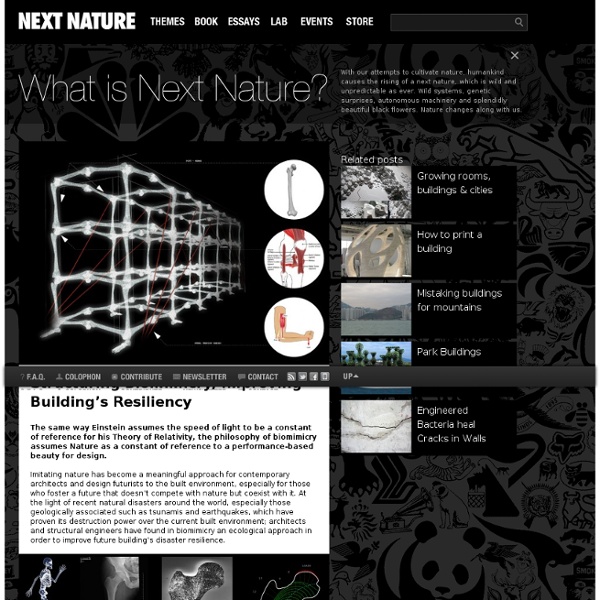Zoom
Trash
Related:



… proving how technology can live in harmony with nature. | redchalksketch Neri OXMAN By JOHN ORTVED | Photography TOM ALLEN Courtesy Imagine a chair that moves when you move, that adjusts to every muscle in your body, that responds like a living organism . . . a chair kind of like a really excellent lover. Raised in Haifa and Caesarea, Israel, by architect parents, Oxman rebelled (well, by academic standards anyway) by going into medicine, completing med school at the Hebrew University of Jerusalem. Oxman usually looks to nature for practical design answers. As for her own future, she rejects any possibility of a Neri Oxman line of roof tiles or a collaboration on Andre Balazs’s next hotel. To learn more about Neri Oxman’s work, visit her Web site and blog. Like this: Like Loading...
Bird Bone Structure At Heart Of ESA’s 3D Lunar Camp | UrtheCast | AJ Plunkett Ah, the mystery of birds. First, they inspire man to fly. Now the ingenuity of their interior may provide us with a foundation for returning to the moon. A hollow, closed-cell structure not unlike that found in the bones of birds has proven to be just the combination of strength and weight necessary to build a habitat out of lunar soil. Of course, a lack of significant amounts of lunar soil on Earth means this is mainly theory for the moment, but the experiments done so far have given us a pretty good indication that it might just work. “3D printing offers a potential means of facilitating lunar settlement with reduced logistics from Earth,” states Scott Hovland of ESA’s human spaceflight team, in an ESA statement. Clean Space Tech The ESA has been investigating using 3D printing technology, also known as additive layer manufacturing, as part of its Clean Space initiative to find innovative technologies to reduce the environmental impacts of the space industry.
Biomimetics One cloudless midsummer day in February, Andrew Parker, an evolutionary biologist, knelt in the baking red sand of the Australian outback just south of Alice Springs and eased the right hind leg of a thorny devil into a dish of water. The maneuver was not as risky as it sounds: Though covered with sharp spines, the lizard stood only about an inch high at the shoulder, and it looked up at Parker apprehensively, like a baby dinosaur that had lost its mother. It seemed too cute for its harsh surroundings, home to an alarmingly high percentage of the world's most venomous snakes, including the inland taipan, which can kill a hundred people with an ounce of its venom, and the desert death adder, whose name pretty well says it all. Fierce too is the landscape itself, where the wind hissing through the mulga trees feels like a blow dryer on max, and the sun seems three times its size in temperate climes. “Ah-ha!” Enter the engineers.
5 Nature-Inspired Innovations The shifting hues of squid skin, the stickiness of gecko toes, the self-cleansing of lotus leaves. Understanding these and other natural phenomena can yield not only fascinating biological insights, but also fresh solutions to today’s most pressing environmental challenges. Biomimicry — applying the design of natural systems to human problems — has gained momentum in recent years. Last August, the San Diego Zoo opened its Center for Bioinspiration, which works with companies and research institutions to translate zoo scientists’ findings into practical applications. Taking cues from nature makes sense. Plants and animals have a 3.8 billion year head start on scientists in adapting to natural pressures, whether that involves using sunlight efficiently or keeping cool in hot, arid climates. 1.) 2.) 3.) A firefly's light results from a chemical reaction that occurs in the cuticle, a part of the insect's protective outer covering. 4.) 5.) Read More: Innovate: Solar Designs from Nature